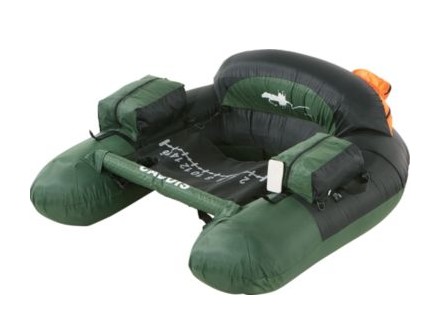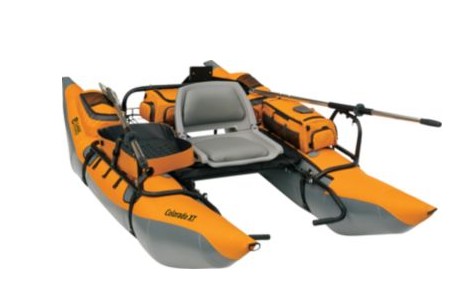Float Tube & Belly Boat Fishing 101 - The Basics
Over the years, I’ve fished a lot of “backyard” fishing holes. Some have been small enough that you could throw a rock across. Then there is my neighbor about 30 minutes to the north, the Great Lake Erie. Regardless of the size of the lake, float tubes give you an option to get off the shore and cover greater areas.
I’ve put a belly boat style float tube in just about every type of water imaginable. Although I fish more often from a bass boat with my wife right now, I’ve got to tell you that fishing from my belly boat is the most enjoyable, plain old FUN way to fish and stay cool on hot summer days. It is exhilarating to be eye-to-eye with a four-pound bass (and BIGGER)!
This three-part article is a guide to float tubing. I want everyone as excited about trying a float tube as I am telling you about it, so I’ll cover it top to bottom and A to Z. Let’s get started…
What Exactly is a Float Tube?
Simply put, a float tube is an inner tube which is covered with fabric with a seat sewn into the middle for you to sit in. This allows for virtually the lowest profile presentation possible. You are literally fishing from less than 30″ high in the water. Try to get that low and be able to cast – comfortably – in any other type of presentation.
Most belly boats today have backrests and storage pockets as well. You can find lower priced float tubes for about $100-$199, while fancier models can go for $300 and up. Let’s look into the differences first.
Original round Boats

I prefer the original-style round boat, also known as a belly boat. My first one is still going strong after 20+ years of fishing trips. The most recent addition to my fleet is also a round style. It has a taller backrest with storage pockets on both sides. And it’s also camouflaged, which was a big selling point with me. This boat cost about $80.00 a few years back, and it is definitely a worthwhile investment.
Round boats have many advantages. They’re the most stable, allow the most storage, and offer the most protection from surface vegetation. They are the most economical choice with some models going for as low as about $100.
Some points for you to consider about a round boat is that while it can seem roomy inside, you cannot lift your knees higher than the bottom of the front of the boat. This may become quite uncomfortable, especially during a long day on the water. You’ll find that the seats are not exactly recliners, but the round boat design is stable enough for you to move your “cheeks” around during the day if you desire.
Also, belly boats are considered to be the most difficult to get into. There are certainly those days when it seems that way! However, as with everything, practice makes for a much more enjoyable experience.
Always get a belly boat that fits YOU. Bigger is not better. You will find that if your boat is too large, a long day on the water will turn into a very sore back. That’s something that can be avoided. If you are like me – a small 160-lb guy – then you simply don’t need one of the largest boats available. Buy wisely.
U-Boat Style Float Tubes

Many newer boats are the U-boat design. This means that instead of a normal inner tube, these boats have special bladders which form the boat to a U shape. You sit in the round part and the front (across the top) closes with a stout bracket or bar. This makes it easier for you to get in and out of the tube, as well as much increased legroom.
But remember, getting in and out is only a couple of minutes at the beginning and end of your trip.
A point to consider about the u-boat design is that it eliminates quick-fixes possible with a round boat. Bladders must be special ordered instead of just going to the tire store for another tube should the need arise.
Now while I don’t have any first-hand experience with a U-shape boat, there are a number of reasons I didn’t choose one. First, I can and do travel forward while I’m float fishing and feel that the U-design would let bugs, weeds, and other stuff right into my lap. Also, I believe the round design to be a little more stable, especially if you’re like me and like to lift yourself up to stretch your legs during a long 8-hour day. U-boats would also seem to be more difficult to maneuver in windy conditions. But again, these are just some points I considered in my own experience.
And when I’m night fishing (which I’ll cover later) I feel much more secure being totally enclosed.
Kick Boats & Hybrid Belly Boats

Within the past six or seven years, there has been a new boat come onto the market called a kick boat. These are small, one person, pontoon-like boats in which your feet are normally in the water. They come equipped with oars, and I imagine they were intended to fill the void between belly boats and jon boats. These kickboats range in price from $250-$1000.
A few considerations with this type of boat is portability and control on the water. These boats are generally sized in the 7′ to 8′ lengths, and may weigh anywhere from 20 pounds and up. I’m looking at a catalog with one at 35 lbs total weight. Now, I don’t know about you, but I think that is a considerable amount of weight to carry around! That’s not even including your tackle and other stuff.
Control is one of the areas where belly boats really shine. Because your feet are always in the water, you can constantly make adjustments. There’s no need to re-adjust a trolling motor for direction or thrust and no need for an anchor, though I’ll touch on those in a minute.
With a kick boat, however, you are sitting higher out of the water with much more boat for the wind to catch. In order for you to keep the position you want, it may be necessary to put down your rod, grab the oars, and position your kick boat where you want it – every time you have the need to do so! Anchors would be a critical part of the gear, and more weight to carry. Even more so if you carry two.
Other Styles of Floaters
I’ve seen pictures of plastic formed belly boats, however I have never seen one in use personally. Stick with the normal inflatable bladder boats. Inner tubes can be repaired easily, and the new boats are equipped with patch kits.
Many of the newer boats are coming with a choice of their regular version and also a camouflage version. You’ll pay a little extra for the camo, but I feel that in the long run this will simply be another advantage in your fishing. Just like all other types of fishing, you want to have every possible advantage on your side.
Recently, I’ve run across ads for a motorized Float tube. Try carrying a 60 lb. trolling motor battery a mile into the woods to the lake and then see if you feel like fishing. If you really want to be motorized then invest in one of the small bass hunter boats and an electric motor, for a number of reasons we won’t get into here.
The very ideal of float tubing is how absolutely simple it is. Your boat, flippers, tackle, and rods and reels might weigh 15 pounds all together. You can easily walk to a remote lake a mile into the woods and have total access to fish that rarely, if ever, see lures.
With a belly boat – You do it ALL with none of the hassle!









